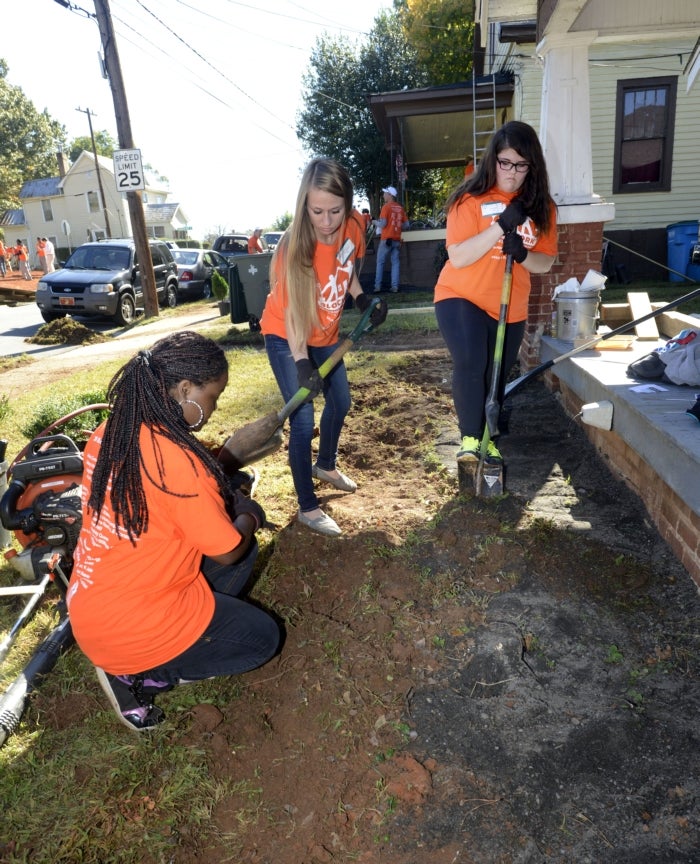BlockWork runs like clockwork: City project transforms part of West Horah Street
Published 12:04 pm Sunday, October 26, 2014

- Mahogane Godfrey, Michaela Fink, and Brandy Kegeris prepare a flower garden at 909 W. Horah Street during the BlockWork project in the 900 block of W. Horah Street. They are student Jr. Civitans from the RCCC Early College. photo by Wayne Hinshaw, for the Salisbury Post
SALISBURY — When 100 people with picks, shovels, rakes, paint brushes, power tools, crowbars and high energy descend on one city block for a day, it can take on the look of a war zone.
“Pandemonium,” said Salisbury Senior Planner Lynn Raker.
But you can’t argue with the results of the BlockWork Project. From 8:30 a.m. to 5 p.m. Saturday, city officials, neighborhood activists, high school and college students, police officers, firefighters, city staff members and just volunteers in general brought significant change to the 900 block of West Horah Street.
As 80-year-old Navy veteran Melvin Massey sat on his porch, a crew above him was tearing off his roof in preparation for nailing on a new one. He already had picked out the color of shingles he wanted.
By the end of the day, Massey had a new roof, a freshly painted porch and landscaping, a pressure-washed sidewalk, a flagpole in his front yard and a new Navy blue rocking chair to sit in.
“I’m glad they’re doing it,” Massey said, smiling at his understatement.
At the house beside him, Samantha Shay and Mike Pavlock were painting all the brown exterior trim.
Across the street, a crew of Junior Civitans from Rowan County Early College were scraping windows and digging out front to install new bushes and flowers.
Mostly high school and college students were digging, scraping and mounding the vacant lot at Vanderford and Horah Street in preparation for a special “earth formation” — an art project designed by Peter Goff, which featured a weeping cherry tree in the middle.
Up and down the street, each property had a site manager, wearing a white ballcap, who made sure his or her crews had the tools and materials they needed for the tasks at hand.
This year’s edition of the BlockWork Project represents the fourth time the Salisbury Community Appearance Commission has formed a partnership with city staff and residents to tackle a specific area for a day.
The Housing Advocacy Commission joined in this year as a cohost.
In 2011, BlockWork spruced up the 200 and 300 blocks of South Shaver Street. In 2012, it was the 1000 block of South Fulton Street; in 2013, the 700 and 800 blocks of East Franklin Street.
“I’m so happy, because I have wanted this for so long,” said Joyce Smyre, who filled out the winning application asking the CAC to consider her block for the annual project.
Smyre, whose family is always host for the big backyard fish fry held every fall for Livingstone College’s homecoming, said she was tickled and grateful to see everyone from Mayor Paul Woodson on down helping her neighborhood.
It’s the kind of work that’s contagious, Smyre said. When one block takes steps to improve its appearance, it leads property owners on other blocks to do the same, she said.
“I’m just overjoyed,” she added.
The 900 block of West Horah holds a lot of history, and these same houses were filled in the past with the families of ministers, teachers, professors and college administrators.
The largest house on the street, which lies directly across from Smyre’s home, once was home to Bishop Jones and his wife.
“When Mrs. Jones lived there, that was a mansion,” Smyre said. Today, the house is divided into boarding rooms and apartments.
But it was the two-story building tucked next to the bishop’s old house that sparked a lot of conversation Saturday. It was once the West End’s hospital, most likely in the days prior to World War II.
Historian Betty Dan Spencer, along with Eleanor Qadirah, are doing some research, trying to find out more, especially the doctors who might have served there. Most people have driven by the structure for years not noticing it and, if they did, not knowing its history as a hospital.
“It was used because they didn’t always admit the blacks to the regular hospital,” Qadirah said.
Salisbury High students who are members of the city-sponsored Salisbury Youth Council gave the brick building’s outside trim a fresh coat of paint before moving to the lot at Vanderford and Horah streets.
William Peoples, site manager for Massey’s house, said BlockWork is the kind of project the city should do more often. It gets people motivated to do more, and it’s good for community relations because of the diverse segments of the city it brings together, Peoples said.
The Junior Civitans from Rowan County Early College had 15 students working all day on the block. At 909 W. Horah St., a crew of Junior Civitans, led by Brandy Kegeris and including Michaela Fink and Mahogany Godfrey, tore off an old handicapped ramp that was no longer needed.
They then started digging a new flower bed, when Mahogany unearthed a sparkling piece of costume jewelry lost long ago.
Down the street at 925 W. Horah St., another crew from the Junior Civitans was helping site manager Belinda Birdsey install a new storm door, paint the porch railings, replace the sconce lights on both sides of the front door and remove a discarded basketball goal from the porch.
“Luckily,” Birdsey said, “I have six girls who like to paint.”
Next door, Kevona Williams and Brittney Shupe, seniors at Henderson Independent High School, also were painting. They said a Salisbury Police officer invited them to work Saturday.
“It’s fun,” Williams said.
Damon Clark, a junior biology major at Livingstone College, said he believes that what you get out of a something is commensurate with what you put in.
“I’m definitely into giving back to the community,” Clark said. “… I didn’t want to be anywhere else on a Saturday morning.”
Evan Dunn, Alexandra Warren and Abraham Post, all seniors at Salisbury High, also belong to the Salisbury Youth Council.
They were all impressed by the transformation that can happen in an area with so many people working together.
“You can still do a lot of good in one day,” Post said.
Lou Manning, a longtime activist in the Park Avenue area, was site manager for a house at the corner of Horah and Institute streets. One of the first orders of business on the property was digging out a huge, unwanted bush.
“The hardest two hours of work,” Manning said. “At 80 years old, it’s kind of tough. We just kept taking turns, wearing it out.”
In addition, Manning’s crew was edging the sidewalks, painting some porch rails and taking care of a tree growing in a house gutter. His guys also grabbed two Salisbury Posts, still in their plastic bags, which had been tossed onto the roof.
“We’ll be done with this pretty quick,’ Manning promised.
Breakfast, lunch and snacks were provided for the volunteers. Salisbury firefighters grilled the hot dogs that were served for lunch in the big side yard next to Smyre’s house.
Ella Woods may have been the day’s happiest worker. In front of Smyre’s house, Wendell Fisher started digging a hole for a new crape myrtle, but he had to leave to take care of another job.
He instructed Woods on what else had to be done, so the rest of the hole was dug, the tree was set in place, and Woods filled in the hole with dirt and also left an irrigation trench as instructed. When Fisher returned, he told Woods, “Dang, you did a good job.”
Woods’ work didn’t go unnoticed by Smyre.
“I’m going to name that tree ‘Ella,’ ” she told Woods, a retired educator.
Driving or walking down West Horah Street in the future will always be special, Woods said.
“I’ve got a tree on Horah Street named for me,” she said. “It’s going to bloom, and it’s going to be beautiful.”
As BlockWork is every year.
Contact Mark Wineka at 704-797-4263.





